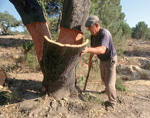- HubPages»
- Home and Garden»
- Home Decorating»
- Interior Design & Decor
About Cork Bark and Cork Flooring
Cork in History
Cork has been used since ancient times. It is an incredibly versatile material that man has been using for millennia. As far back as 2500 BC the ancient Egyptians were using cork for fishing floats. The ancient Greeks were the first civilization to use cork as stoppers for wine and olive oil vessels. And the Romans used cork for house roofs, beehives, ships and women’s shoes. Nowadays cork is used for a variety of purposes including making cork flooring tiles.
Man harvesting cork bark

Harvesting Cork
Cork comes from the cork oak tree. It is a renewable resource because the cork oak can be harvested every nine years for its precious bark. Removing the bark from the cork oak tree, if properly done, does not damage the tree. The secret is to remove the outer bark while keeping the inner bark on the tree to protect the tree against insect and fungal attack.
The cork oak is ready to harvest for its bark after 20 years.
More Cork Resources
- Sustainable Flooring and Green Interior Design
- Cork Underlayment - Best Choice For the Environment
If you are installing hardwood, bamboo, coconut or laminate flooring you are going to need underlayment. One of the best types of underlayment is made from cork. - Cleaning Cork Flooring
A guide to cleaning cork flooring. - A Comparison between Strand Woven Bamboo Flooring and Cork Flooring
Both strand woven bamboo flooring and cork flooring are sustainable flooring types because they are made from renewable resources. - Buy Cork Flooring
Cork is perhaps the most environmentally friendly flooring type available for purchase. Cork like bamboo, rattan, jute, hemp and water is a renewable resource. - Suberin in Cork Flooring
Cork is a renewable resource that makes excellent flooring. One of the reasons that cork is a good material for flooring is that it contains suberin. - Browse various style of cork flooring tiles
Cork flooring is an ideal alternative to hardwood flooring: it is strong, durable and anti allergenic.
Virgin cork and refugo cork
The first bark that is removed is called ‘virgin bark’. This bark has a rough uneven exterior and has too many wide pores to be used for flooring. Instead it is normally ground up and used for insulating material or cut into smaller pieces and used for ornamental pieces and for reptile habitats.
After nine years the second bark can be harvested. This is called ‘refugo bark’. This bark is much smoother and has a more even texture. It is also browner in color. However, the second growth bark still has too many wide pores and is usually ground up like virgin bark and used for insulating materials.
It is the third and subsequent harvests of ‘refugo bark’ that have fewer and more tightly closed pores that is suitable for other uses.
Once the cork bark is removed from the tree it is left in the forest to dry and to possibly be inspected by potential buyers. Then it is taken to a factory where it is boiled. This boiling process removes the outer woody part of the bark and makes the cork more elastic and easy to work with. Then the best pieces of cork are selected and they are ground up into fine pieces. These pieces are then compressed with a low VOC adhesive to produce a block of cork. From this block it is a simple matter to cut the cork into various sizes for products including cork flooring tiles.








